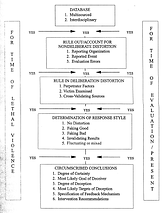
Deception and Distortion Analysis
The Deception and Distortion (D&D) Analysis is embedded in the violence risk analysis. This is because a person must have an idea as to what is real, and true and valid before rendering conclusions about anything. A database chock full of fascinating and verifiable information regarding violence could easily lead us in erroneous directions if intentional deception and unintentional distortion are not taken into account. As much as possible, each datum and/or dataset needs to be cross-validated by at least 2 sources. The more cross-validation the better.
PERMISSION HAS BEEN GRANTED BY STEVE POLLARD, PHD
TO REPRODUCE THE ABOVE DIGITAL PAINTING "GENESIS"
Genesis
Deep passions of the heart and soul expressed as swirling reds and yellows from the primal
id of the subconscious boil to the surface in a therapy session when a woman comes
to grips with the death of her parents and emerging growth of her own children and how they must
grow to leave her becoming their own lights and colors. The smaller flecks of color are
the continuing influences of one on the other. If you look closely
you can see her face (and others) in the image.
CLICK TO VIEW DECEPTION ANALYSIS RETROSPECTIVE DECISION TREE
It is essential to determine which of 5 main styles are shown by the possible violent person or victim. These are:
- (1) Honesty from the perspective of the person evaluated. An honest but stressed eyewitness may yield a wrong identification of a perpetrator. As an example, operational teams may not have access to critical information, dooming their mission from the start;
- (2) Faking good involves intentionally hiding or minimizing information, or pumping up one’s positive points in order to achieve a distinct goal. Faking good is probably the most effective style of lying in that a partial truth is difficult to rebut as a deliberate falsehood. Faking good can be uncovered by cross-validating information, confession, and use of relevant methodology (e.g., polygraph, Explicit Alternative Testing using the binomial distribution).
- (3) Faking bad involves exaggeration of negative features, fabrication of problems, or hiding positive points, always in the service of an ulterior motive. Pretending to be psychotic in order to beat a murder rap is one example. Faking bad is easy to discover because the faker needs to invest constant time and effort to maintain consistency. Records can also reveal that a person is malingering, a form of faking bad.
- (4) Invalidation is a fourth style, attempting to nullify for example the outcome of a forensic evaluation. Not showing up for an examination, marking the tests wrong, or doing something else to render useless the efforts of the evaluator to uncover truth are examples of this style. (Several perpetrators have vomited on the test protocols or suddenly become otherwise ill in order to invalidate testing).
- (5) Combination styles are also seen, and in fact are the most common as fakers find it almost impossible to show a specific style 100% of the time. A person may tell the truth in the beginning, for example, then switch to faking good or bad on specific issues, then return to honest responding. Overall, at least 2 dozen D&D strategies over two time periods (e.g. time of evaluation, time of previous violence) can thus be employed by the evaluee.
A decision tree helpful in conducting a deception analysis is presented in diagram above, which also discusses the problem more in detail and provides helpful guidelines in order to achieve a better approximation of truth. The recommended criterion threshold to accept that a particular style of deception is utilized by the director is 6, all in one direction, corresponding to a result by chance of less than one in a hundred. The decision tree for possible D&D is presented below with a full explanation of each step found in the following book:
Hall & Poirier's (2001) Detecting Malingering And Deception: Forensic Distortion Analysis (See BOOKS Page).


